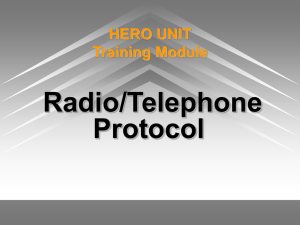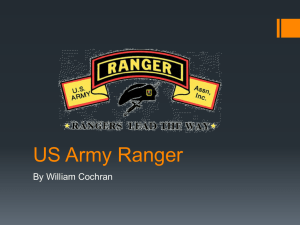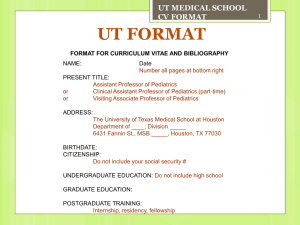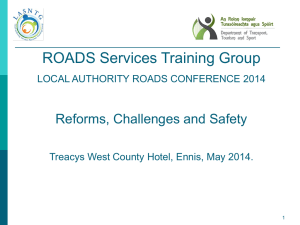Road Ranger Work Zones
advertisement
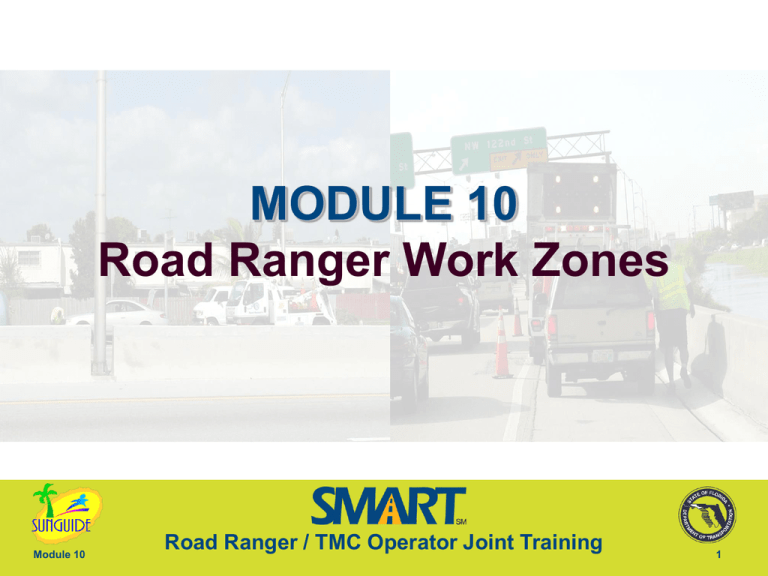
MODULE 10 Road Ranger Work Zones Module 10 Road Ranger / TMC Operator Joint Training 1 Purpose of the Course To train personnel who may be required to assist motorists and emergency personnel within the highway right-of-way, as part of their Road Ranger Duties. Module 10 Road Ranger / TMC Operator Joint Training 2 Objectives of the Course • To familiarize Road Ranger participants with the concepts and terminology of setting up a work zone in emergency situations. • To gain knowledge and understanding of the equipment, techniques and Procedures necessary for the Road Rangers to safely maintain traffic flow using standards from the MUTCD and DS 600 Series Indexes. • To upgrade the performance of personnel establishing work zones on State and Federal highways. Module 10 Road Ranger / TMC Operator Joint Training 3 Follow • All WZTC operations and devices must conform to: • Manual on Uniform Traffic Control Devices for streets and highways (MUTCD) • Design Standards (DS) Module 10 Road Ranger / TMC Operator Joint Training 4 Basic Safety Principles ● Traffic safety in temporary traffic control areas should be an integral and highpriority element of every project from planning through design and construction. ● Traffic movement should inhibit as little as possible. ● Drivers and pedestrians should be guided in a clear and positive manner while approaching and traversing the temporary traffic control zone. Module 10 Road Ranger / TMC Operator Joint Training 5 Basic Safety Principles ● To ensure acceptable levels of operation, routine inspection of traffic control devices. ● To maintain a good message with the motoring public, upgrade MOT when materials become availably during the life of the temporary traffic control zone. Module 10 Road Ranger / TMC Operator Joint Training 6 Basic Safety Principles ● The control of traffic in an emergency situation is an essential so all agencies can do their part to open the roads to the motoring public quickly and safely ● Maintaining good public relations is necessary. Module 10 Road Ranger / TMC Operator Joint Training 7 What can we expect Module 10 Road Ranger / TMC Operator Joint Training 8 Basic Requirements for Traffic Control Devices • • • • • Module 10 Fulfill a need Command attention Convey a clear, simple meaning Command respect of road users Give adequate time for proper response Road Ranger / TMC Operator Joint Training 9 Qualified Product List • Only approved traffic control devices that are listed on the QPL may be used. • Approval number shall be engraved on the device in a visible location. • Water – resistant labels may be used Module 10 Road Ranger / TMC Operator Joint Training 10 Function of Traffic Control Devices • To warn and alert drivers of hazards created by work zone activities. • To guide and direct drivers and pedestrians safely past the hazards. Module 10 Road Ranger / TMC Operator Joint Training 11 Placement • Channelizing devices must be placed to provide a smooth and gradual transition in moving traffic through the work zone Module 10 Road Ranger / TMC Operator Joint Training 12 TRAFFIC CONES and TUBULAR MARKERS • COLOR - Orange shall be the predominant color and should be kept bright and clean for maximum target value. • USE - Cones and tubular markers are applicable for daytime use. For nighttime use, cones must be reflectorized. Module 10 Road Ranger / TMC Operator Joint Training 13 Traffic Cones Module 10 Road Ranger / TMC Operator Joint Training 14 Cone Spacing • Maximum spacing between cones shall be 25 feet (8 paces) Module 10 Road Ranger / TMC Operator Joint Training 15 Cones • Only used when workers are present • Not to exceed 2 miles or a 12 hour work period • One person to maintain them • Reflective collars when used at night Module 10 Road Ranger / TMC Operator Joint Training 16 Arrow Panels • USE - Intended to supplement other warning devices. • Provide additional advance warning • Used for lane closures on high-speed, high volume multi-lane roadways. • Left indication shall never be displayed on a lane closure on a two-lane, two-way highway. Only CAUTION mode(s) will be used on these types of highways. Module 10 Road Ranger / TMC Operator Joint Training 17 Arrow Panels MODES – PASS LEFT – PASS RIGHT – PASS EITHER SIDE – CAUTION Module 10 Road Ranger / TMC Operator Joint Training 18 Size: Panel Type Type A Type B Type C Type D Arrow Panels Minimum Size (inches) 48 X 24 60 X 30 96 X 48 Must conform to an arrow Type A: For use on low-speed urban streets Type B: For intermediate-speed facilities and for maintenance operations on high speed roadways. Type C: Intended to be used on high-speed, high volume traffic control projects. Module 10 Road Ranger / TMC Operator Joint Training 19 Arrow Panels • Nighttime Use - When Advance Warning Arrow Panels are used at night, the intensity of the flashers shall be reduced. • Location - For lane closures on multi-lane roadways, an arrow panel should be located on the shoulder at the beginning of the taper. An alternate location is centered in the closed lane behind the taper channelizing devices near the beginning of the taper - if shoulder space is not available. Module 10 Road Ranger / TMC Operator Joint Training 20 Intensity (Arrow Board Brightness) • High intensity during the day • Low intensity during the night Module 10 Road Ranger / TMC Operator Joint Training 21 Warning Signs Module 10 Road Ranger / TMC Operator Joint Training 22 Guide Signs Guide signs generally have a rectangular shape with the long dimension horizontal. The basic color for guide signs is white on green. At work zones , guide signs may be black on orange to indicate routing changes due to the maintenance activity. Information signs which relate to the work being done and detour route are black legend on an orange background. Module 10 Road Ranger / TMC Operator Joint Training 23 Road Ranger Flagging Module 10 Road Ranger / TMC Operator Joint Training 24 Module 10 Road Ranger / TMC Operator Joint Training 25 Flagger - Qualifications • • • • • Sense of responsibility Trained in safe traffic control practices Average intelligence Good physical condition Mental alertness and ability to react in an emergency • Courteous but firm • Neat appearance Module 10 Road Ranger / TMC Operator Joint Training 26 Module 10 Road Ranger / TMC Operator Joint Training 27 Module 10 Road Ranger / TMC Operator Joint Training 28 TRAFFIC CONTROL OPERATION • Operations in response to emergencies, varies according to the nature, duration, location of work, type of roadway, speed of traffic, and the potential hazards • Upgrade MOT when material becomes available during the life of the temporary traffic control zone Module 10 Road Ranger / TMC Operator Joint Training 29 Units of Measurement • ODOMETER: – 1/10 of a mile on the odometer equals 500 feet (actual 528). This provides a safety margin of 28 feet each 1/10 of a mile. • REFLECTIVE PAVEMENT MARKERS [RPM]: – Presently spaced 40 feet apart. – Skip Strip - 40 feet from start to start Module 10 Road Ranger / TMC Operator Joint Training 30 Approaching the Site • Do we have to push? • Close the shoulder? • Close the Lane? Module 10 Road Ranger / TMC Operator Joint Training 31 Shoulder • Park 30 to 50 feet behind • Display Caution Mode • Set Cones Module 10 Road Ranger / TMC Operator Joint Training 32 Lane Closure • Park 30 to 50 feet behind • Display Arrow in the direction you want traffic to flow. • Set up cones Module 10 Road Ranger / TMC Operator Joint Training 33 Set-up Scenarios Module 10 Road Ranger / TMC Operator Joint Training 34 Shoulder MOT Setup DAV 30 ft 25 ft Road Ranger 25 ft 25 ft 10 ft 30 ft Module 10 Road Ranger / TMC Operator Joint Training 35 Module 10 Road Ranger / TMC Operator Joint Training 36 Module 10 Road Ranger / TMC Operator Joint Training 37 Upon Arrival - Road Ranger #1 Arrive, Assess, Advise, Assist Crash Module 10 Crash 30 ft Road Ranger Road Ranger / TMC Operator Joint Training 38 Road Ranger #2 MOT Maintenance Crash Crash Fire Rescue 30 ft RR #1 Law enforcement RR #2 Module 10 Road Ranger / TMC Operator Joint Training 39 SIRV ARRIVAL MOT UPGRADE Crash Crash Fire Rescue 30 ft RR #1 Law enforcement SIRV RR #2 Module 10 Road Ranger / TMC Operator Joint Training 40 Module 10 Road Ranger / TMC Operator Joint Training 41 PROPER SET UP • First sign up • Last sign down Module 10 Road Ranger / TMC Operator Joint Training 42 So what do we need? • • • • • Vinyl Signs for day or night operations Sign Stands Traffic wand or reflectorized red flag Stop slow paddle Some type of flood light for nighttime flagging operation Module 10 Road Ranger / TMC Operator Joint Training 43 Module 10 Road Ranger / TMC Operator Joint Training 44 Discussion! Module 10 Road Ranger / TMC Operator Joint Training 45
